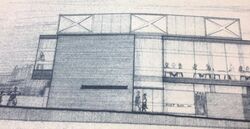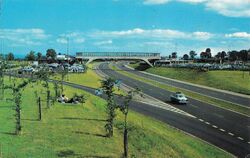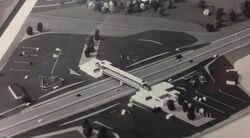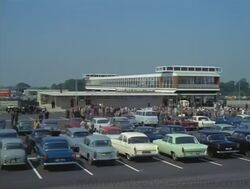History of Charnock Richard services
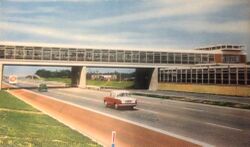
The services shortly after opening.
Charnock Richard, Keele and Knutsford were all identified at the same time, forming part of the plans for the M6. An additional site at Broughton was held in reserve while problems with it were investigated.
Charnock Richard was pushed through because the road through here would be opening first, making it the oldest service area on the M6 when it opened in July 1963. It had been hoped that Charnock Richard could wait long enough to collect feedback from Watford Gap and Newport Pagnell, but the priority was to have it open with the motorway, so everybody involved had to assume that the previous examples were working well.
Tendering
See also: M6 Service Area Planning
In planning, it was sometimes called Heskin services.
The demand for catering here was expected to be low, and consideration was given to having it open and selling fuel only, but this was thought to be too big a risk with possible high levels traffic heading for Blackpool.
The minimum spend allowed in the plans was £100,000. Designs were encouraged to have restaurants on bridges which was regarded by the inspectors as an efficient and impressive design.
Airborne Catering Ltd
As was the case with many of their bids, Airborne Catering Ltd produced a poor design, poor catering proposals but a suspiciously promising financial offer. This design had everything on the bridge.
What was interesting was that this was the fifth service area Airborne had bid for, and each bid was bigger than the previous one. They had still failed to prove they were a financially stable business but continued to promise more. They were again pulled up for their lack of attention to detail.
Their architect was Sydney Clough, Son & Partners, who also designed Knutsford.
Airborne would have used a new brand name if they had won.
Kenning Motor Group
Buoyed by winning the tender for Strensham, here Kennings planned a restaurant and café close to a footbridge with transport cafés further away, by the lorry parks, based closely on Strensham. Their financial offer was particularly poor. As a garage firm, it wasn't clear who would be responsible for a catering.
Loxhams Garage
In their plan, Loxhams had the restaurant and a café on the bridge with transport cafés further away.
Their financial offer was poor, but they showed expert knowledge and were told they would make a good operator.
W. Blamire
This plan had a restaurant and transport café at each end of a footbridge. The building would have used buff bricks and stone. There would have been underfloor heating in the restaurant and transport café. The first floor café would be used as an open air café but could be covered. There would be polished hardwood tables with individual leather upholstered chairs, and wallpapered walls.
Their landscaping efforts were poor. As an operator, they showed experience, and were told they "would do a good job".
Their architect was H W Weedon, who also designed Watford Gap.
Oliver Hart
Oliver Hart had a double-decker bridge with a pedestrian crossing running underneath a restaurant, with a café and transport café at each end of the bridge.
Their catering arrangements would be contracted out to Robley Ltd, who had a good reputation from their work at Liverpool Airport. Plastic furniture would be used.
Shadsworth Garage Ltd
This design had a restaurant and café on the bridge, joined by two transport cafés. Their landscaping was attractive.
Motorway Services Ltd
Ministry of Transport, 1961
The Fortes and Blue Star combined firm made a grand plan, inspired by American chain Howard-Johnson and designed by Terence Verity, who also worked on Keele. It had an entrance hall, snack bar and toilets on the ground floor, the snack bar alongside the motorway, and a café and restaurant on the bridge. The bridge-restaurant, called Grill and Griddle, could hold nearly 300 customers. It involved a massive investment and a very strong catering proposal. Their landscaping effort was the best of all the offers.
The proposal was similar to their offer for Keele, but without the water towers and with a few minor changes. Their use of escalators was called "a world-first". Motorway Services Ltd had a financial offer which was placed in joint-first place, joined by the Airborne windfall. It was described as "simple, orderly, compact and efficient".
This was the only plan which had an effective road layout. Each side had a large car park around the building, and a small parking area for other large vehicles at the end. There was a large forecourt across the front on each side, each with ten islands.
Their use of the bridge was about providing "good views", and the café would be "bright and comfortable". The bridge-restaurant had muted lighting and tables set into individual glass-sided booths while the café was a bright and light room.
The Ministry were aware Motorway Services Ltd had made an impressive bid for all three of the new M6 service areas, but each one was judged on its own merits.
Operation
In the middle of the identified site was a large pylon which cost £7,700 to clear. In total the Ministry spent about £227,000 on preparing the land, and Motorway Services Ltd spent a further £370,000. Lancashire Constabulary wanted a large building at Charnock Richard, to make it the headquarters of their motorway division.
An official opening ceremony was held on 29 July 1963, commemorating both the service area and the completion of this section of the M6.
In 1964, the trade at the service area (which was associated with holiday seasons in Blackpool and The Lake District) was described as being "full of fluctuations". The northbound side was busier, especially its café.
On the southbound side, fuel was originally available on the immediate left. The back of what's now the northbound car park was originally for HGVs.
Charnock Richard was the most complained about service station in 1976, mainly because of its high food prices.
Te BBC planned a documentary about Charnock Richard services in 1975, but it didn't go ahead. One was broadcast on BBC Radio Blackburn in April 1979, which looked at the emergencies which can happen at the service area.
The motorway network's first Little Chef opened on the bridge in 1982. It was removed around 1996. In 2006, that bridge had to be restructured because it was close to falling on to the motorway.
A report dated 1986 said the service area was employing 200 people, and serving 3,000 meals a day.
Over time, Charnock Richard's concept of placing the forecourt before the car park has fallen out of favour, both for safety reasons and because it goes against customer expectations. The northbound forecourt was moved to the former police unit area in the 1990s, but the southbound forecourt is still in its original position and remains a rare example of a forecourt being placed very close to the exit from the motorway. This risk was brought home in June 2021 when an errant HGV very nearly collided with the forecourt.
Hotel
The American-style motel was attached to the service area on a separate parcel of land, where it was immune from the government's regulations. When this opened in 1974, the government were surprisingly open to the idea, as they realised the additional custom would lead to more food sales and therefore more tax income.
Forte were experimenting with the idea of motorway hotels at the time, and this one included a breakfast bar. It was one of the first TraveLodges to open in the UK, using a much more upmarket styling than they would become known for. The hotel became one of the early Welcome Lodges, later a Days Inn, and in 2018 it received a thorough refurbishment and a new entrance to become a Ramada.
Survey Results
The 2022 Transport Focus survey calculated a 93% satisfaction score for the northbound services and 83% for the southbound services, making it the third-worst in the UK. The following year, both sides scored 95%, placing them firmly in the middle.
In 2021, Which? Magazine ranked Charnock Richard 52nd out of the 68 service areas they visited.
In Spring 2018, a Transport Focus survey calculated a 93% satisfaction score from northbound customers and an 92% from southbound customers. By 2019 this had dropped down to 79% and 77% respectively, placing it among England's worst five services.
In 2015, the southbound services were rated 3 stars by VisitEngland, but the northbound side was one of few to be given a 5 star rating. It was by far the oldest building to win this title. VisitEngland highlighted the cleanliness and presentation of Waitrose and the levels of service and knowledge experienced from most of the staff.
In May 2012 and August 2011, VisitEngland rated the services as 3 stars.
In 2008 the southbound services won a five star loo award.
In 2007, Charnock Richard won a four star loo award.
In 2006, Holiday Which? gave the services a 2 out of 5.
In 2005 and again in 2006 they won a five star loo award.
A newspaper visited in 1994 and called the food "prehistoric", but it noted that the ambience was bright and colourful.
The food was criticised in the 1991 Which? survey.
In 1977, Egon Ronay rated the services as "poor". He said its standards "were not wholly low, but no high point was achieved", while the standard Forte menu relied heavily on convenience food. One particular meal - fish which may have been haddock - was "not fit for human consumption".
A 1967 government inspection summarised their visit as being hit with "an impression of bleakness".
